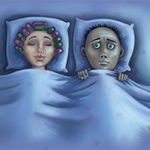

Twenty years of schooling and they put you on the day shift.
—From “Subterranean Homesick Blues,” Bob Dylan
A Springtime Rite
For many years, one of the bureaucratic rituals that heralds the arrival of spring has been the submission of the annual fellowship program training survey to the Accreditation Council for Graduate Medical Education, better known as the ACGME. Program directors are asked to reply to a host of questions, with most of these queries focusing on the nuts and bolts of the training that is offered. Do fellows have access to electronic medical records? Are faculty members available to discuss cases after clinic hours? Does the on-call schedule comply with the recently implemented ACGME duty-hour rules? Can the program director confirm the location of the rheumatology fellows’ on-call room? That last question always makes me chuckle. Maintaining a call room for rheumatology fellows? What a waste of space that would be! After all, we are fortunate to work as specialists who are rarely summoned to the hospital late at night to deal with pressing clinical concerns. The thought of having a dedicated on-call room seems oxymoronic and I feel as though publicizing the location of this room to our fellows could stir some after-hours mischief.
The Good Old Days
However, the people running the ACGME are not pranksters. They are dead serious about requiring programs to comply with duty-hour regulations and have not hesitated to sanction some of the most prestigious training programs that have violated the work rules. For decades, the need to work long, grueling hours was considered a requisite part of medical training. It was supposed to make you a tougher, smarter doctor. Many readers will recall those insufferable days of yore, when being on call for entire weekends or for three nights in one week was not unusual. Caffeine, and lots of it, got some of us through those lengthy mind- and body-numbing shifts, although the house staff lounge in the Montreal hospital where I trained also kept a converted Coke machine well stocked with ice-cold pints of Molson Ale. Quelle vie!
Work Hours Get Slashed
About a decade ago, the rules began to change. The impetus was the publication of a series of observations by the Harvard Work Hours, Health, and Safety Group, based at the Brigham and Women’s Hospital in Boston, on the effects of extended work shifts and the increased frequency of both serious medical errors and motor vehicle accidents among interns. The first study compared the rates of serious medical errors made by interns while they were working according to a traditional schedule with extended (24 hours or more) work shifts every other shift (an “every third night” call schedule) and while they were working according to an intervention schedule that eliminated extended work shifts and reduced the number of hours worked per week.1 The total rate of serious errors on the critical care units was 22% higher during the traditional schedule than during the intervention schedule. During the traditional schedule, interns committed 20% more serious medication errors than during the intervention schedule and made 5.6 times as many serious diagnostic errors. These researchers concluded that physician sleep deprivation may be harmful to patients, but subsequent studies suggested that it could pose a serious health hazard for the doctors themselves. Using a web-based survey of over 2,700 interns, they observed that the odds ratios for reporting a motor vehicle crash and for reporting a near-miss incident after the completion of an extended work shift were 2.3 and 5.9 respectively, when compared with a shift that was not of extended duration.2 Every extended work shift increased the monthly risk of a motor vehicle crash by 9.1%, and increased the monthly risk of a crash during the commute from work by 16.2%. With over 8,000 medical trainees working in my city at any given time, I think I have finally solved the puzzle about why Boston drivers are so exceptionally bad!
These findings, along with other studies that reached similar conclusions, prodded the ACGME to establish new duty-hour rules. These regulations were adopted nearly seventy years after Congress directed the Interstate Commerce Commission to establish hours of service rules for another group of shift workers, namely truckers. It seems that a fully loaded eighteen-wheeled truck looming in your rearview mirror strikes more terror and trepidation than watching a bespectacled, studious, yet exhausted intern making life-and-death decisions in the 26th hour of their work shift.
Playing with the rules of nature that disrupt the natural sleep–wake cycle and other circadian rhythms can be hazardous to everyone’s health.
What Jet Lag Can Teach Rheumatologists
Circadian rhythms are a universal phenomenon found across all plant and animal species. In the early 1700s, the French astronomer Jean-Jacques d’Ortous de Mairan demonstrated that the leaves of Mimosa pudica continue to open and close every 24 hours, even when the plant was enclosed in a sealed box. The invention of artificial light, followed by the creation of night-shift work and the advent of jet travel have all disrupted the natural pattern of alignment between the external light–dark cycle and our internal clock, which was set to a 24-hour day early in evolution.3 The circadian clock, identified in the 1970s as being situated in the suprachiasmatic nuclei (SCN) of the hypothalamus, promotes alertness during the day and sleep at night.
Now that most readers are presumably beyond the stage of training requiring lengthy shift work, the most likely situation to cause sleep deprivation (other than raising kids!) would be jet travel. Jet lag is a recognized sleep disorder that results from crossing time zones too rapidly for the circadian clock to keep pace, resulting in a temporary misalignment between the clock and local time. The clock is slow to reset, so after several time zones have been traversed, the endogenous signals for sleep and wakefulness fail to match the local light–dark and social schedules.
Sleep is not a luxury, rather it is a critical component of the circadian cycle. Though inadequate sleep can be harmful, especially when driving or operating heavy equipment, the total lack of sleep can be fatal, as evidenced by the rare syndrome of familial fatal insomnia, a prion disease caused by a mutation at codon 178 of the prion protein gene.4 Affected individuals develop a rapidly progressive and ultimately fatal disease characterized by untreatable insomnia, dysautonomia, and pathologic motor signs.
Though most of my patients are not jet-setters, one does not have to look too far to recognize the impact of normal and altered circadian rhythms on selected rheumatologic diseases. Perhaps the paradigm disease would be gouty arthritis, particularly podagra. As Thomas Sydenham observed in 1683, “The victim goes to bed and sleeps in good health. About two o’clock in the morning, he is awakened by a severe pain in the great toe.”5
Another example is the quotidian fever curve observed in patients with adult Still’s disease. As fellows, we were taught to always check in on our patients with Still’s disease during the mid to late afternoon, when the likelihood was greatest for witnessing the characteristic salmon-colored rash that heralded their fever spike. Of course, morning stiffness is so highly characteristic of polymyalgia rheumatica or ankylosing spondylitis that its absence from the history of a patient suspected of having either diagnosis essentially rules out these conditions.
Circadian Cytokines
What might tie circadian rhythmicity to these inflammatory diseases? The first clues began to emerge following the discovery of cortisol. Researchers identified a circadian rhythm involving the hypothalamus–pituitary–adrenal axis that generated a maximal cortisol secretion peak around 8:00 AM and a nadir around midnight. When graphing the relationship between cortisol levels and time of day in healthy individuals, a single sharp peak is observed. However in patients with severe rheumatoid arthritis (RA), this peak is flattened and replaced by two peaks, one in the morning and the other in the afternoon.6 Following the discovery of the critical roles played by tumor necrosis factor (TNF) and interleukin (IL) 6 in the pathogenesis of RA, their circadian rhythms were also noted to differ from those of healthy controls. In patients with RA, the peak level of TNF appears around 6:00 AM and that of IL-6 at 7:00 AM, indicating a delay of three and one hours, respectively. In healthy subjects, serum levels of TNF and IL-6 start to decline by 6:00 AM and 9:00 AM, respectively, whereas in RA patients, elevated levels persist for several more hours. More importantly, the height of the secretion curves for these two cytokines is about twentyfold greater than in controls. Using a mouse model of systemic inflammation, researchers concluded that secretion of TNF-alpha can interfere with the expression of circadian rhythm–related genes, impair locomotor activity, and enhance the proclivity for rodents to rest.7 Might a similar situation be at play in RA?
To Be or Not To Be A Morning Person
Taken together, these observations readily explain why most patients with RA don’t consider themselves to be morning people. In fact many of us hate starting our days at the crack of dawn. Mornings are relatively stressful times for our bodies. The probability of nontraumatic death, as well as stroke, ST-elevation myocardial infarction, and ventricular arrhythmia, varies by time of day, with a peak occurring in the late morning or early afternoon. In a recent long-term study of candidate gene associations in patients with sleep disorders, it was observed that among a large cohort of older patients, two common polymorphisms near the PER1 gene, a key regulator of circadian rhythms, could segregate individuals into either early or late risers.8 Among those who died of natural causes, the presence of the early-riser polymorphism correlate with the likelihood of a mid- to late morning time of death, while the late-riser polymorphism was associated with the individual’s death occurring seven hours later, in the early evening. Tick, tock; chronobiology can be eerie.
Timing Is Everything
In life, and even in death, timing may be everything. This was further highlighted using a creative approach that demonstrated how experimentally induced circadian disruption that mimicked jet lag altered innate immune responses. By regularly shifting the light–dark cycles in a group of mice that were exposed to the hazards of lipopolysaccharide (LPS)-induced septic shock, investigators found an enhanced mortality rate of 895, compared to just 21% in the unshifted control mice.9 Although sleep deprivation and stress are known to alter immune function, polysomnographic recordings in the mice exposed to the shifting schedule revealed no sleep loss, and stress measures were not altered in the shifted mice.
In contrast, the authors observed altered or abolished rhythms in the expression of clock genes, not only in the central clock, but also in the liver, thymus, and peritoneal macrophages. Is it possible that circadian disruption, rather than simply sleep loss or stress, is responsible for the jet lag–related dysregulation of the innate immune system seen in shift workers? Perhaps this would explain why a lovely patient of mine, Patty, with longstanding, well-controlled RA, recently experienced what she described was the “worst flare-up of her life.” Her therapeutic regimen had not changed; she had not been ill, nor had she traveled. However, for the past four weeks, her nursing shift working in a cardiac care unit had been changed from daytime duty to an overnight shift. This single alteration appeared to be responsible for her RA disease activity score to have nearly tripled from its usually steady baseline value. Though Patty’s case was extreme, I am certain that over the years I have missed other more subtle examples of shift work affecting disease activity.
The Eyes Have It
Light is the strongest and most important environmental timing clue and in mammals can only be perceived by the eyes. A morning blast of strong light can spring us up and out of bed, but at night it can interfere with our ability to fall asleep. When light passes through our eyes, a selective group of recently identified photosensitive ganglion cells initiates the process of signal transfer to the suprachiasmatic nucleus. Exposure to bright daytime light enhances nocturnal secretion of melatonin, the primary product of the pineal gland and a key molecule for inducing sleep.
Besides inducing somnolence, melatonin has potent antioxidant effects and it has been suggested that it may have anticancer properties. The ‘‘melatonin hypothesis’’ postulates that light at night as opposed to daytime exposure, may be an important factor in explaining the higher cancer risks found in industrialized countries. In fact, in 2007, the World Health Organization (WHO) declared shift work to be a probable carcinogen. Since melatonin levels are naturally higher in blind persons, what is their cancer incidence? Indeed, the incidence of most types of cancers in blindness is half that of sighted people of either gender, a relationship that also holds for visual loss. Blind women have half the incidence of breast cancer compared to sighted cohorts. Strikingly, in a cohort of over 17,000 persons followed for 20 years, the incidence of breast and prostate cancer was directly correlated with visual acuity.10
Yes, timing is everything. A morning burst of exposure to the short wavelength (blue) portion of the visible light spectrum can provide your system with the equivalent of a much-needed jolt of caffeine. Just don’t try repeating this exercise at night. After dark, put away your light-emitting gadgets or you may start feeling the way you did as an intern … following a 26-hour shift.
Dr. Helfgott is physician editor of The Rheumatologist and associate professor of medicine in the division of rheumatology, immunology, and allergy at Harvard Medical School in Boston.
References
- Landrigan CP, Rothschild JM, Cronin JW, et al. Effect of reducing interns’ work hours on serious medical errors in intensive care units. N Engl J Med. 2004;351:1838-1848.
- Barger LK, Cade BE, Ayas NT et al. Extended work shifts and the risk of motor vehicle crashes among interns. N Engl J Med. 2005;352:125-134.
- Bass J. Circadian topology of metabolism. Nature. 2012;491:348-356.
- Medori R, Tritschler HJ, LeBlanc A, et al. Fatal familial insomnia, a prion disease with a mutation at codon 178 of the prion protein gene. N Engl J Med. 1992;326:444-449.
- Sydenham T. The Works of Thomas Sydenham, vol II. London, Sydenham Society, 1850, p 123.
- Straub RH, Cutolo M. Circadian rhythms in rheumatoid arthritis. Arthritis Rheum. 2007;56:399-408.
- Cavadini G, Petrzilka S, Kohler P, et al. TNF-alpha suppresses the expression of clock genes by interfering with E-box-mediated transcription. PNAS. 2007;104:12843-12848.
- Lim ASP, Chang AM, Shulman JM et al. A common polymorphism near PER1 and the timing of human behavioral rhythms. Ann Neurol. 2012;72:324-334.
- Castanon-Cervantes O, Wu M, Ehlen JC, et al. Chronic circadian disruption dysregulation of inflammatory responses by chronic circadian disruption. J Immunol. 2010;185:5796-5805.
- Turner PA, Mainster ML. Circadian photoreception: Ageing and the eye’s important role in systemic health. Br J Ophthalmol. 2008;92:1439-1444.

